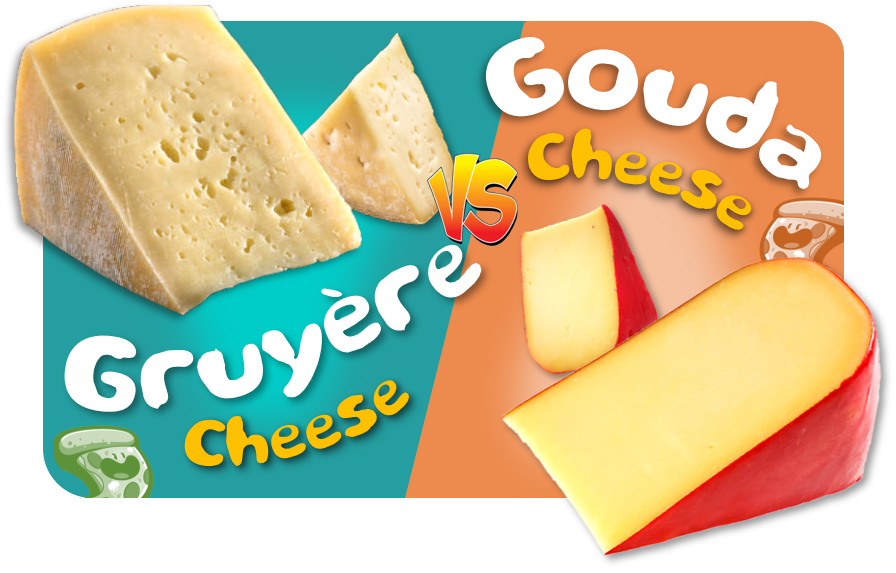
Ah, cheese, that scrumptious dairy delight that makes us swoon. Whether you’re a casual cheese eater or a full-blown connoisseur, you’ve likely crossed paths with Gruyère and Gouda, two of the most popular cheeses around. But have you ever stopped to wonder what sets them apart? Is Gruyère’s earthy flavor superior, or does the mild fruity flavor of a young Gouda win the day? In this showdown of dairy deliciousness, we’ll compare these two titans of the cheese world, side by side. We’ll dig deep into their origins, dive into their flavors and textures, and explore how they shine in different dishes. We’ll even clue you in on the best substitutes for each, just in case your local grocery store runs out. So grab a glass of white wine (maybe a Sauvignon Blanc?), and let’s embark on a tasty journey through the wonderful world of Gruyère and Gouda cheeses.
What Makes Them Unique?
Gruyère Cheese: The Alpine Star
Originating from the idyllic Alpine region of Switzerland, Gruyère cheese has long been a staple in European cuisine. The cheese’s moniker is drawn from the district of La Gruyère in Fribourg, a canton known for its lush landscapes and impeccable dairy farming. Made from unpasteurized cow’s milk, this type of Swiss cheese has become one of the most popular cheeses, not just in Europe, but globally.

What makes Gruyère stand out from other kinds of cheese? It’s the meticulous aging process that adds depth to its distinct nutty flavor. Traditionally, Gruyère wheels are aged for several months, some even for years, in humidity-controlled cellars. This aging process gives it that signature firm texture, speckled with small holes, that you’ve likely seen on a decadent cheese board.
Gouda: The Dutch Marvel
On the other side, we have Gouda, a Dutch cheese that’s also made its way into the hearts of cheese lovers worldwide. Named after the city of Gouda in the Netherlands, this type of cheese is a popular choice in grocery stores and specialty shops alike. Unlike Gruyère, Gouda cheese can be made from various types of cow’s milk, both pasteurized and unpasteurized.

Gouda’s flavor profile is as versatile as its age. A young Gouda offers a mild, almost sweet taste, while an aged Gouda turns complex, embracing a rich flavor that can be both caramel-like and nutty. The aging process for Gouda is similarly varied, ranging from a few weeks for younger versions to several years for aged varieties.
What Sets Them Apart? Characteristics of Gruyère and Gouda
Flavor Profile
Gruyère: The Distinct Nutty Flavor
When it comes to flavor, Gruyère is a force to be reckoned with. This type of Swiss cheese offers a complex palette of tastes, from its signature earthy flavor to its underlying sweet undertones. It’s a great option for those who appreciate a multifaceted, mature cheese. The longer the aging process, the deeper these flavors become, reaching a unique blend of savory and sweet that tickles the taste buds.
Gouda: From Mild to Bold
In contrast, Gouda provides a versatile spectrum of flavors that change with its age. A young Gouda is delightful in its simplicity, offering a mild fruity flavor that pairs well with light snacks and wines. As it ages, the taste of Gouda undergoes a transformation, adopting a richer, more caramel-like profile. Aged Gouda is a great choice for anyone looking for a cheese that can hold its own in a variety of dishes, from pasta to cheese sandwiches.
How About Their Texture?
The Semi-Hard Texture of Gruyère
Gruyère, a semi-hard cheese, has a firm texture that’s both pliable and smooth. It features small holes scattered throughout, the result of its traditional aging process. This characteristic texture makes it an excellent choice for both slicing and melting, especially in recipes that call for good melting cheese, like French onion soup.
Gouda’s Creamy Texture
Unlike Gruyère, Gouda offers a variety of textures depending on its age. Young Gouda has a creamy, almost buttery texture that’s perfect for cheese sandwiches or as a table cheese. As it matures, it develops a firmer texture that becomes increasingly granular, a testament to its complex aging process.
How Versatile Are These Cheeses?
A Versatile Cheese Board Addition

Both Gruyère and Gouda make fantastic additions to any cheese board. Their unique flavors and textures can elevate a simple selection of cheeses into an artisan experience.

And when it comes to wine pairings, both are excellent choices.

Gruyère pairs wonderfully with white wines like Sauvignon Blanc, while Gouda’s rich flavor complements red wines such as Pinot Noir.
For those who prefer non-alcoholic options, fruit juices and herbal teas also make great pairings.
In the Kitchen
Gruyère: The Swiss Delight
This type of Swiss cheese is incredibly versatile, making it a popular ingredient in a variety of dishes. Its excellent melting qualities make it a perfect choice for French onion soup, as well as a host of pasta dishes. Its semi-hard texture holds up well in both hot and cold recipes, from quiches to salads. Simply put, Gruyère is the type of cheese that can seamlessly integrate into your culinary repertoire, satisfying both your savory and sweet cravings.
Gouda: The Dutch All-Rounder
Similarly, Gouda’s creamy texture and versatile flavor profile make it a great option for a wide range of culinary uses. It’s a good choice for cheese sandwiches, thanks to its smooth texture in its younger form. Aged Gouda, with its firmer texture and richer flavors, can stand alone as a table cheese or be incorporated into more complex dishes, like casseroles and gratins. Its adaptability makes it an excellent substitute when you’re out of other semi-soft cheeses like Havarti or Monterey Jack.
Can’t Find Your Favorite Cheese?
Sometimes life throws us curveballs, and we can’t always get our hands on our favorite type of cheese. Whether it’s a lack of stock at grocery stores or just an adventurous culinary spirit, you may find yourself seeking a worthy substitute for either Gruyère or Gouda. Fret not; there are plenty of great options.
Excellent Substitute Choices for Gruyère

When it comes to finding an excellent substitute for Gruyère, your best bet is Emmental cheese. Originating from Switzerland, Emmental offers a similar nutty flavor with a slightly milder touch. Another good substitute is American Swiss cheese, which mimics the small holes and semi-hard texture of Gruyère but at a more affordable price point.

If you’re in a real pinch, Jarlsberg cheese can also fill in. It’s a kind of cheese that hails from Norway but offers a flavor profile and texture similar to Gruyère. And if you’re looking for a cheese with a mild flavor, Havarti could work in less traditional recipes.
Great Options for Gouda Substitutes

When Gouda is unavailable, Edam cheese is often the first alternative that comes to mind. This Dutch cheese shares a similar flavor profile with young Gouda and has a semi-soft texture that melts well. Monterey Jack cheese is another great option, particularly in recipes that call for melted cheese. If you want cheese with a creamy flavor, Fontina can also be a perfect substitute, especially in recipes that require soft, meltable cheese.
Here’s a special read… Edam VS. Gouda Cheese


Muenster cheese can also be a solid stand-in for Gouda, especially when you’re aiming for a cheese that balances well with both savory and sweet dishes. It has a smooth texture and a similar taste, making it a versatile cheese that can adapt to a range of recipes.
Here’s a special read…Muenster Cheese Substitute
Are These Cheeses Healthy?
Cheese often gets a bad rap for its fat content, but when consumed in moderation, both Gruyère and Gouda offer some surprising health benefits.
Nutritional Perks of Gruyère
Gruyère is rich in protein and calcium, thanks to the unpasteurized cow’s milk from which it’s made. While it’s true that this kind of cheese is calorie-dense, its high protein content makes it a fulfilling option that can keep you satiated for longer periods. The aging process of Gruyère also leads to the development of probiotics, those beneficial gut bacteria that aid in digestion.
Goodness in Gouda
Gouda, especially the aged variety, is a nutritional powerhouse in its own right. High in both protein and calcium, aged Gouda has the added benefit of being rich in Vitamin K2, a nutrient that helps with blood clotting and bone health. Additionally, Gouda contains a variety of minerals such as phosphorus and zinc, which contribute to overall well-being.
While both cheeses are an excellent source of essential nutrients, it’s important to remember that they should be enjoyed in moderation. Pair them with fruits or whole-grain crackers for a balanced snack that pleases both your taste buds and your health.
Does the Season Affect Your Cheese?
Seasonal Gruyère
Gruyère, being made from the milk of cows that graze in the Alpine region, can vary in flavor depending on the season. Spring and summer varieties tend to be lighter and more floral due to the fresh pastures on which the cows graze.
Gouda Through the Seasons
Gouda’s flavor can also change depending on what the cows have been eating. Seasonal varieties may feature a herbaceous quality in the spring and a richer, more buttery flavor in the fall.
How Do You Keep Your Cheese Fresh?
Preserving Gruyère
Gruyère can be stored in the refrigerator, wrapped in wax paper, and then placed in an airtight container. It usually keeps well for up to a month. For long-term storage, you can also freeze Gruyère; just be sure to wrap it tightly to prevent freezer burn.
Storing Gouda
Gouda should be stored similarly to Gruyère but generally has a shorter shelf life, especially if it’s a younger variety. Wrap it in wax paper and store it in an airtight container in the refrigerator for up to two weeks. Aged Gouda, however, can last up to a month if stored properly.
Which Will You Choose?
Choosing between Gruyère and Gouda ultimately boils down to personal preferences and the dish you’re preparing. Whether you’re in search of a cheese with a creamy texture for your next cheese sandwich, a firmer texture for a sumptuous pasta dish, or a versatile option for your cheese board, both cheeses offer unique attributes that make them an excellent choice. Explore, experiment, and most importantly, enjoy your cheesy adventure!




